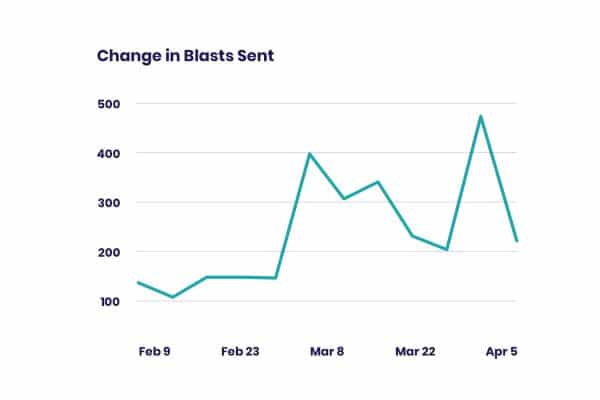Cerkl’s Data Scientist analyzed our clients’ COVID-19 crisis communications metrics and shares what you can apply to your digital employee communications work.

.webp)
Measure the ROI of using modern internal communications. Get the template for free without any risk or commitment. Access Now
Access NowIt’s no surprise that crisis communications have been the central topic among internal communicators since well before the World Health Organization declared COVID-19 a pandemic. I am always humbled by the fantastic work that our IC community has accomplished during this pandemic. The understanding of a work-life balance as we know it has changed and communications strategies must change alongside it. Where better to start than by analyzing your channel and employee metrics during COVID-19?
To provide numerical insights, I wanted to see precisely how COVID-19 has impacted our clients’ employee digital communications. I turned to our Data Scientist, Kyle Johnson, to examine anonymous aggregate trends from a representative sample of our top internal communications clients.
To grab a snapshot of the state of corporate communications before COVID-19 impacted us all, Kyle pulled metrics from February 1 to April 30, 2020. He examined four key insights and measurements over that period:
Broadcast Email Blasts is best used for when an internal communicator wants to send a single message outside of their personalized newsletter ecosystem. Kyle took a deep dive into the delivery metrics of this particular part of the Broadcast suite to see if there were any interesting changes in its use during a crisis communications situation that touched every company in the world
Broadcast Email Digest is an automated compilation of internal content that delivers based on employees’ individual interests, schedule, language, and format to make sure that they receive critical business communications. Personalized Newsletters and Email Blasts work best when partnered together. So, it was natural for Kyle to dig into the analytics for Personalized Newsletters to see the full story of how internal communicators used email to keep their employee audience safe and informed.
Kyle wanted to look at different delivery metrics, such as open and click-thru rates with the corresponding times. Did delivery times or frequency change the employees’ interest in content?
Finally, Kyle wanted to see what the overall employee engagement was for Personalized Newsletters. How were they being used and did employees engage with them more or less during the immediate fallout of COVID-19 related closures and relocations?
Check out my behind-the-scenes interview with Kyle Johnson as he discusses his research.
https://vimeo.com/417288368
“Around the middle of March, when governors began issuing stay-at-home orders, schools were closed, and March Madness got canceled,” says Kyle. “Companies needed to apply continuity measures to their communications strategies. I found that our Email Blasts communications spiked by more than 300%.”
Most of our clients minimized their “business as usual” content, focusing on communicating closures, policy, and safety updates.
As Cerkl’s Business Solutions Architect, I speak directly with our internal communicators. They are tirelessly working to make sure their employees receive the news, updates, and information they need to be successful. Many have shared that Email Blasts have championed their crisis communications strategy. It has been easier to send out targeted communications between business continuity planning meetings.
In times of crisis, Email Blasts are the go-to communication vehicle for distributing messages to employees. We see that communication spiked in mid-March and then again to a higher degree in mid-April.

Based on Email Blasts data, we can conclude that our internal communications clients began the second phase of communications in early April. They were then sharing extended stay-at-home order guidance from key states and looking ahead to sharing transition plans for how their companies will resume normal operations.
Email Blasts data also indicates that most new business initiatives remain on the back burner, and the search for the “new normal” was (and still is as of publishing) on.
When our IC clients began the second phase of communications, we observed that some of these messages were not all relegated to email, instead they were published in other communications channels and packaged within company newsletters.
There is no doubt that internal communicators have played a pivotal role in supporting their businesses and employees through the COVID-19 crisis. While the peak of the first wave has passed, analyzing employee data can prepare you for the “new normal” or a potential second wave.
While we all hope that we won’t have a second wave to prepare for, streamlining our communications processes now allows us to continue to be proactive and plan for the next time our crisis communications skills are necessary.
How do successful organizations navigate crisis communication? Get the template they use for free, no risk, no commitment.
Want feedback? If you complete it, we will provide you with free, personalized advice on how to improve. Get started using your email.